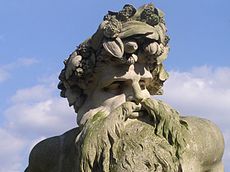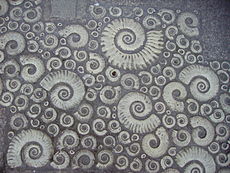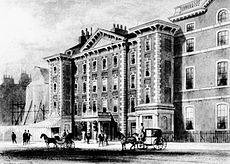- Coade stone
-
Lithodipyra (Stone fired twice - Ancient Greek (λίθος/δίς/πυρά)), or Coade stone, was ceramic stoneware that was often described as an artificial stone in the late 18th and early 19th centuries. It was used for moulding Neoclassical statues, architectural decorations and garden ornaments that were both of the highest quality and remain virtually weatherproof today. Produced by appointment to George III and the Prince Regent, it features on St George’s Chapel, Windsor; The Royal Pavillion, Brighton; Carlton House, London; the Royal Naval College, Greenwich, and a large quantity was used in the refurbishment of Buckingham Palace in the 1820s.[1][2]
Lithodipyra was first created around 1770 by Mrs Eleanor Coade who ran Coade's Artificial Stone Manufactory, Coade and Sealy, and Coade in Lambeth, London, from 1769 until her death in 1821.[1] [n 1] [n 2] [n 3] After which Lithodipyra continued to be manufactured by her last business partner William Croggon until 1833.[1] [3]
Contents
History
Main article: Eleanor CoadeIn 1769 Mrs Coade bought Daniel Pincot’s struggling artificial stone business at Kings Arms Stairs, Narrow Wall, Lambeth, a site now under the Royal Festival Hall.[2][4] This business developed into Coade's Artificial Stone Manufactory with Eleanor in charge, such that within two years (1771) she sacked Pincot for 'representing himself as the chief proprietor'.[2][1][5]
Mrs Coade did not invent 'artificial stone', various inferior quality precursors having been both patented and manufactured over the previous forty (or sixty[3]) years, but she was probably responsible for perfecting both the clay recipe and the firing process. It is possible that Pincot's business was a continuation of that run nearby by Richard Holt, who had taken out two patents in 1722 for a kind of liquid metal or stone and another for making china without the use of clay, but there were many start-up 'artificial stone' businesses in the early 18th century of which only Mrs Coade's succeeded.[6][4][7]
The company did well, and boasted an illustrious list of customers such as George III and members of the English nobility. In 1799 Mrs Coade appointed her cousin John Sealy, already working as a modeller, as a partner in her business, (Her mother’s sister Mary’s son),[7] which then traded as 'Coade and Sealy' until his death in 1813 when it reverted to just 'Coade'.
In 1799 she opened a show room Coade’s Gallery on Pedlar's Acre at the Surrey end of Westminster Bridge Road to display her products.[1][2][8][9] (Image of the entrance to Coade and Sealy's Gallery of Sculpture, Westminster Bridge, 1802)
In 1813 Mrs Coade took on William Croggan from Grampound in Cornwall, a sculptor and distant relative by marriage (second cousin once removed). He managed the factory until her death eight years later in 1821[9] whereby he bought the factory from the executors for ca. £4000. Croggan supplied a lot of Coade stone for Buckingham Palace, however, he went bankrupt in 1833 and died two years later. Trade declined, and production came to an end in the early 1840s.
The material
Coade stone is a type of stoneware. Mrs Coade's own name for her products was Lithodipyra, a name constructed from ancient Greek words meaning "stone-twice-fire" (λίθος/δίς/πυρά), or "twice fired stone". Its colours varied from light grey to light yellow (or even beige) and its surface is best described as having a matte finish.
The ease with which the product could be moulded into complex shapes made it ideal for large statues, sculptures and sculptural façades. Moulds were often kept for many years, for repeated use. One-offs were clearly much more expensive to produce, as they had to carry the entire cost of creating the mould.
One of the more striking features of Coade stone is its incredible resistance to weathering, often faring better than most types of stone in London's harsh environment. Examples of Coade stonework have survived very well; prominent examples are listed below, having survived without apparent wear and tear for 150 years.
As a material, Coade stone was replaced by Portland cement as a form of artificial stone and it appears to have been largely phased out by the 1840s.
Quality controversy
Although Coade stone's reputation for both weather resistance and manufacturing quality is virtually untarnished, there are three offline sources that describe Rossi's statue of George IV erected in the Royal Crescent, Brighton as unable to withstand the weathering effects of sea-spray and strong wind: such that, by 1807 the fingers on the sculpture's left hand had been destroyed, and soon afterwards the whole right arm dropped off. [10] [11] [12] By contrast however Fashionable Brighton, 1820-1860 by Antony Dale (online) describes similar damage as 'wore badly' but does not attribute 'broken fingers, nose, mantle and arm on an unloved statue' to weathering or poor quality Coade stone. In 1819, after considerable complaints, the relic was removed and its present state is undocumented.[13]
The formula
Contrary to popular belief the recipe for Coade stone still exists, and can be produced. Rather than being based on cement (as concrete articles are), it is a ceramic material.
Its manufacture required special skills: extremely careful control and skill in kiln firing, over a period of days. This skill is even more remarkable when the potential variability of kiln temperatures at that time is considered. Mrs Coade's factory was the only really successful manufacturer.
The formula used was:
- 10% of grog
- 5-10% of crushed flint
- 5-10% fine quartz
- 10% crushed soda lime glass.
- 60-70% Ball clay from Dorset and Devon.
This mixture was also referred to as "fortified clay" which was then inserted after kneading into a kiln which would fire the material at a temperature of 1,100°C for over four days.[14]
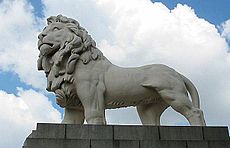 The Red Lion, aka the South Bank lion, on Westminster Bridge. Modelled by William F. Woodington and Grade II* listed by English Heritage
The Red Lion, aka the South Bank lion, on Westminster Bridge. Modelled by William F. Woodington and Grade II* listed by English Heritage
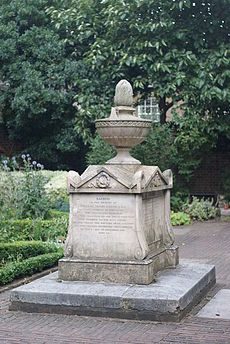 Captain William Bligh's Tomb surmounted by a breadfruit in a bowl
Captain William Bligh's Tomb surmounted by a breadfruit in a bowl
Examples
Main article: Eleanor Coade- Mrs Coade's country home, Belmont House in Lyme Regis, Dorset, displays examples of Coade stone on its façade.
- The pavement outside the Philpot Museum, Lyme Regis, decorated with the shapes of Ammonites set in its surface. The paving has proved durable enough to survive the wear of myriad footfalls over the years.
- The Lion at the south end of Westminster Bridge in central London originally stood atop the old Red Lion Brewery, on the Lambeth bank of the River Thames. When the brewery was demolished in 1950, to make way for the South Bank Site of the 1951 Festival of Britain, the Lion was taken down and put on display at street level. When removed, the initials of the sculptor William F. Woodington and the date, 24 May 1837, were discovered under one of its paws.[3] The fine details still remain clear after 170 years of London's corrosive atmosphere, caused by heavy use of coal throughout the 19th and first half of the 20th centuries. The red paint was removed to reveal the fine Coade stone surface to view. In 1966[15], the statue was moved from outside Waterloo station[16] to its current location.[17]
- Duff House Mausoleum, Wrack Woods, Banff, Aberdeenshire, Scotland. The second Earl of Fife built this mausoleum for his family tombs in 1791, possibly on the site of a Carmelite friary. Built before the Gothic Revival, this is an example of "Gothick" architecture. Typically of the Georgians the carvings, including the monument to the first Earl, are in ceramic Coade stone.
- Nelson's Memorial at Burnham Thorpe
- Britannia Monument in Great Yarmouth
- Nelson's Pediment on the Old Royal Naval College, Greenwich, regarded by the Coade workers as the finest of all their work.
- Twinings' first ever (and still operating) shop's frontispiece, in the Strand, London opposite the Royal Courts of Justice, rediscovered under soot after a century.
- Schomberg House on Pall Mall, London
- Captain Bligh's tomb (in the churchyard of St Mary's Lambeth)
- Lord Hill's Column, Shrewsbury, Shropshire
- Rio de Janeiro's zoo entrance
- St Mary's Church gate, Tremadog, Gwynedd, Wales.
- Richmond upon Thames. Two examples of the River God, one outside Ham House, the other in Terrace Gardens.
- Buckingham Palace (in a section not open to the public)
- Castle Howard
- A couple of large ornate urns in the Italian Garden at Chiswick House, London
- Royal Pavilion in Brighton
- Imperial War Museum (sculptural reliefs above the entrance)
- The Buttermarket in Chichester, which was designed by John Nash (coat of arms engraved with "Coade & Sealey 1808")
According to BBC research, over 650 pieces are still in existence worldwide.[18]
See also
Notes
- ^ There is some modern confusion between Eleanor and her mother (Eleanor, Elinore), as to which one ran the factory. This is primarily due to Miss Eleanor Coade's customary use of the title Mrs because this was a commonplace 'courtesy title' for any unmarried woman in business. However, analysis of the bills shows that Eleanor Coade (daughter) was fully in charge from 1771. (Alison Kelly, Oxford National Dictionary of Biography (ONDB))
- ^ Alison Kelly states on page 23 of Mrs Coade's Stone - "Since mother and daughter had the same name, confusion has reigned over the contribution of each of them to the manufactory. The widow Coade was of course Mrs, and it has been assumed that any mention of Mrs Coade must refer to her. Rupert Gunnis, for instance, believed that the widow ran the factory until her death, in her late eighties, in 1796. What is not generally realised is that women in business, in Georgian times, had the courtesy title of Mrs, So Mrs in the Coade records, normally refers to Miss Coade. Bills were usually headed Eleanor Coade, but two, as early as 1771, for Hatfield Priory, Essex, and 1773, for work at Burton upon Trent Town Hall, were made out to Miss Coade, showing that from the early days she was in charge. The only references which specifically concern the mother are the first two entries for the factory in the Lambeth Poor rate books, when the rate was paid by Widow Coade."
- ^ It appears that the modern identity confItusion dates from 1951 (or earlier) when Sir Howard Roberts and Walter H. Godfrey published the Survey of London: volume 23 - Lambeth: South Bank and Vauxhall, where inadequate research about the Coade family genealogy lead to both gaps and false conclusions. Typically this state of knowledge was then reiterated by Rupert Gunnis in his 1953 Dictionary of British Sculptors, 1660-1851. More recently the 'British History Online' website has given credence to the otherwise excellent Roberts and Godfrey Survey of London on their prestigious website (British History.ac.uk) and some other internet sites have repeated the claims.
References
- ^ a b c d e Oxford National Dictionary of Biography - Eleanor Coade
- ^ a b c d Addidi Inspiration Award for Female Entreprenneurs. Eleanor Coade by Dr. Nicola Phillips, Kingston University, May 2009
- ^ a b c Roberts, Howard; Godfrey, Walter H. "Coade's Artificial Stone Works". Victoria County History. 23: Lambeth: South Bank and Vauxhall. http://www.british-history.ac.uk/report.aspx?compid=47044#fn2.
- ^ a b Parks and Gardens. Eleanor Coade - artist in artificial stone. By Timur Tatlioglu.
- ^ Yale University Library, Coade's Lithodipyra, or, Artificial Stone Manufactory
- ^ Alison Kelly, Mrs. Coade's stone (1990)
- ^ a b Fairweather, History of Coade stone, Synopsised from original research in Mrs Coade's Stone by Alison Kelly.
- ^ JStore. Architectural History, Vol. 28, 1985. Coade Stone in Georgian Architecture by Alison Kelly
- ^ a b van Lemmen, Hans (2006). Coade Stone. Princes Risborough, England: Shire. p. 6. ISBN 0-7478-064466.
- ^ Musgrave, Clifford (1981). Life in Brighton. Rochester: Rochester Press. ISBN 0-571-09285-3.
- ^ Carder, Timothy (1990). The Encyclopaedia of Brighton. Lewes: East Sussex County Libraries. ISBN 0-861-47315-9.
- ^ Antram, Nicholas; Morrice, Richard (2008). Brighton and Hove. Pevsner Architectural Guides. London: Yale University Press. ISBN 978-0-300-12661-7.
- ^ Google Books online. Fashionable Brighton, 1820-1860 by Antony Dale. page 39
- ^ "A Couple of Dogs that Never Need Feeding, And Other Garden Gems", by Wendy Moonan; pg. B36 of the New York Times, 28 April 2006
- ^ http://www.flickr.com/photos/alistairhall/2171675089/
- ^ Coad/Coode Family - History of people from the West Country of England called Coad, Coode and variants
- ^ Google Streetview image of Lion on Westminster Bridge
- ^ BBC TV documentary series "Local Heroes", episode "South-East", 2004
External links
Gallery of images.
- Plate 48: A view of Westminster Bridge, 1791. shows King's Arms Stairs in the foreground (possibly) with a sign advertising Coade's factory.
- COADE'S ARTIFICIAL STONE MANUFACTORY, circa 1800
- Plate 38a: Coade's Artificial Stone Manufactory 1801
- Plate 39a: The entrance to Coade and Sealy's Gallery of Sculpture, Westminster Bridge, 1802
- Coade stone factory, Narrow Wall, Lambeth, London, c1800.
- Coade and Sealey's Artificial Stone Factory, by Thomas Hosmer Shepherd
Categories:- Stone
- Building stone
- Building materials
- Ceramic materials
- Garden features
- Architectural elements
- Sculptures
Wikimedia Foundation. 2010.

